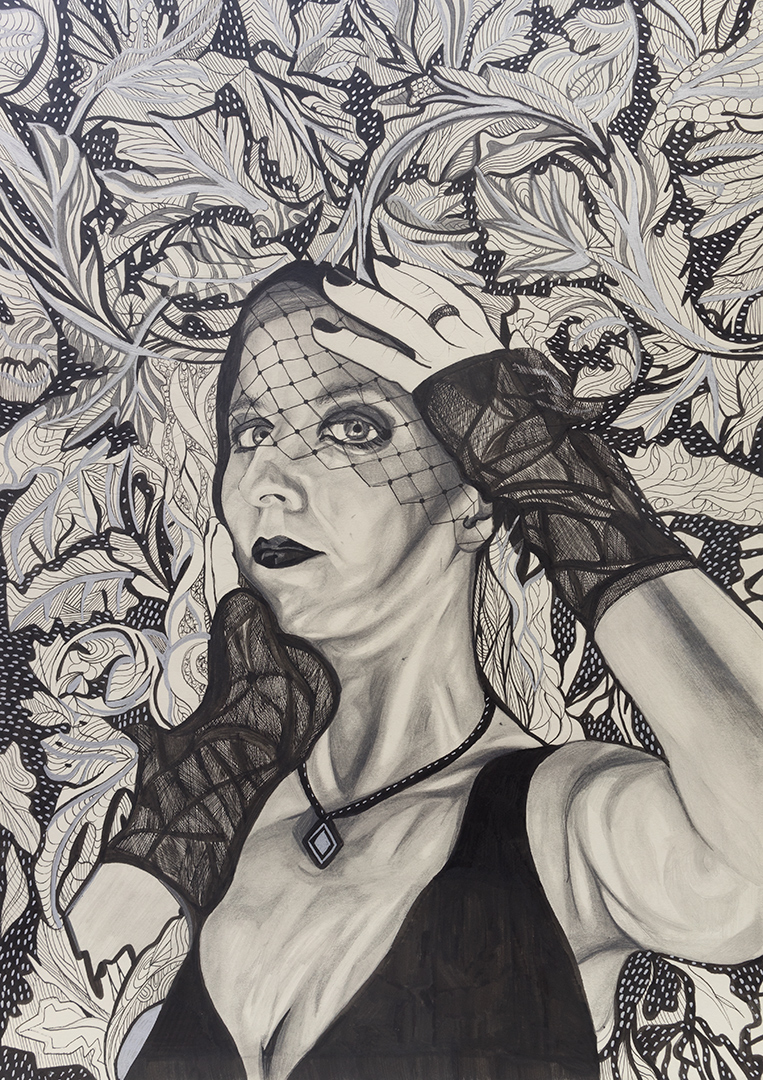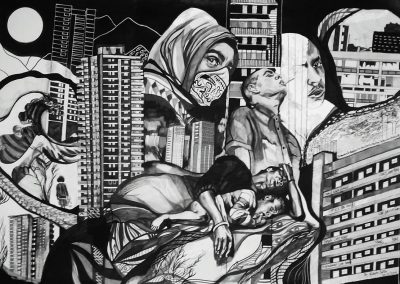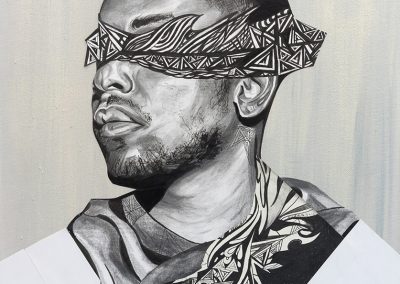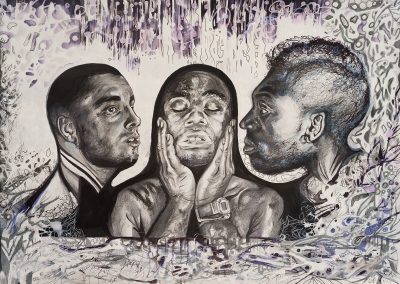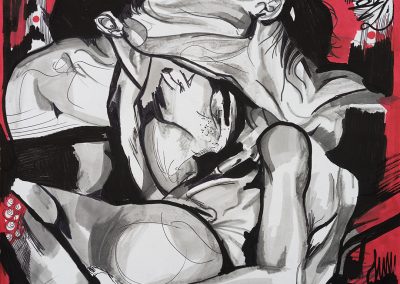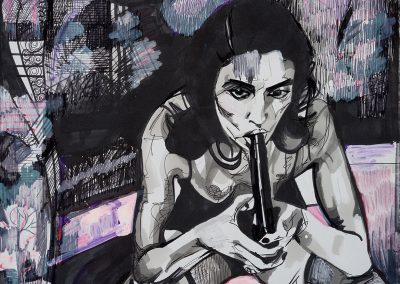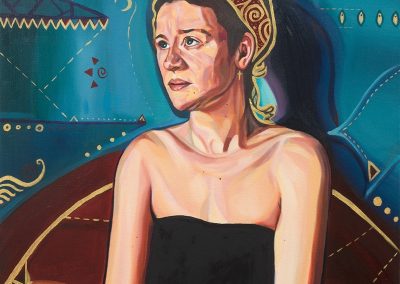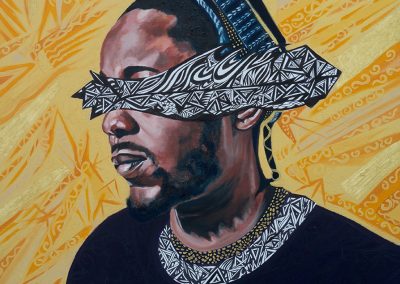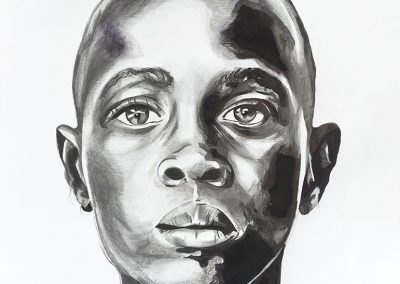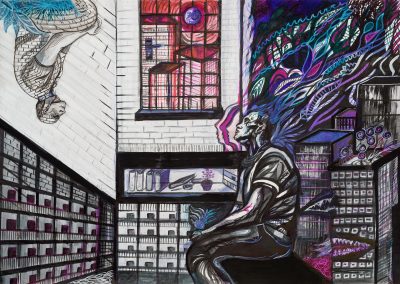Michelle
Michelle Dalton is an Irish artist, a voice-hearer and survivor living in Cork, Ireland. She is the Chair of the Hearing Voices Network Ireland, and was one of its founding members.
Michelle is a self taught mixed media artist, as well as a writer, concert curator, founder of the ‘Music for the Mind’ festival, social entrepreneur and spokesperson for the Mental Health, Recovery and Human Rights Activists in Ireland. You can find out more about her work on her website.
Please tell us about this piece of work. How is it linked to your experience of hearing voices?
As an artist, I explore a multiplicity of diverse experiences, including hearing voices. My reality and work is a deviation from the norm as I hear voices and experience vivid visions which are filled with multi-layered metaphorical and existential complexities. I command and channel these complexities through art. I live with this experience naturally without any form of medically-induced social control, so my inner worlds, my voices and my imagination are all freely expressed in my artistic work.
My artistic process is a form of passionate dissociation, like a creative possession. The various voices I have create a person with many minds and personalities – each with their own opinions and personalities. Most importantly, and as my life’s art work shows, they each have their own artistic style.
I work without perfection where the work is a safe and sacred place to express the landscape of my inner world. My work also has a socially conscious motivation. So, I create art from a diverse range of experiences and materials that are both personal and politically motivated like a visual dialogue with my selves (voices) and my perception of our contemporary society and how we live in it.
How (if at all) does making art help you cope with or explore your voices?
As an artist and voice-Hearer I see beauty in chaos but get nothing but chaos back for being beautiful. My work reflects a life that was previously imbued with chaos but made meaningful again through art. I no longer like to use the words “cope” in relation to my voices. They are part of me and I don’t just cope with myself, I am very comfortable and content with who I am now.
People think making art is an isolated experience, a lonely occupation. But it’s the solution to loneliness. The Artist is with someone – , a voice – when she is creating. This relationship is very sacred and private. Art is the kind of companion, where loneliness ceases to exist. This is particularly true in relation to hearing voices because you never really are alone.
The working relationship between my voices and my art creates a visual narrative acknowledging the reality of the intense feelings of the world of the inner traumatized child and help create a place where the truth is safe from being abandoned or neglected. My art and creativity in essence is a safe home for my voices.
Art is my main connection that transcends the reality of the mind to the reality of the external world particularly in the construction and deconstruction of our personal histories and the preservation of the inner child.
Creativity and art are conscious weapons against any force that threatens to stop us from connecting with our true selves. Through whatever medium we can take those shattered and lost parts of us and create a piece of art that makes us whole again.
On a day when they have been triggered by something not related to my making I find it very hard to focus on my art, I’m too agitated or shaky. Sometimes I can start something in a shaky way and out of it a conversation emerges and something can settle but that is often a slow process but if I can stick with it, something progressive in my understanding can occur. The outcome is more about my relationship with my voices rather than a resolved piece of work but it can inspire another piece when I’m more able to focus.
Some stages of work when I’m making a printing plate is primarily mechanical. If I’ve drawn the image and just cutting the plate, following the lines I’ve already made, I can be more meditative and can either choose to defer listening or engage with them. If they get very demanding I can stop and listen. It’s a learning to live with them alongside an occupation that is also important. It helps me learn to cope with them and maybe, because making art has become so important to me, I can be stronger in negotiating with them. I increase my tolerance of them and they, in turn, increase their tolerance of me being more assertive, which is what they want!!!! It can sound circular and it is but it’s a journey of slowly spiralling upward to greater self-expression and resilience. I believe that anyway!
What role do your voices play in the creative process? Do they inspire you or do they sometimes ‘get in the way’?
People have this perception that if you hear voices you have some sort of disability, a disadvantage. There was a time when I was indoctrinated into the psychiatric environment that I thought this was true. But now I see that I have a different experience that gives me a heightened sense of sound and an elevated consciousness. This is an advantage not a disadvantage, a gift and not a disability. In terms of art and creativity voices are an extra material to draw inspiration from. Voices can critique the work in both the skill of the delivery and themes that are forming within it. They also encourage a mixing of genres and styles. Hearing voices and being an artist is like operating within a community of artists, with each voice being a different artist with their own unique style. So their role in my creative process is profoundly important. This is apparent in my work as the form, approach, style and subject matter is constantly evolving and changing as I am naturally a curious person. Which is why I love art as the possibilities of what you can do is endless.

